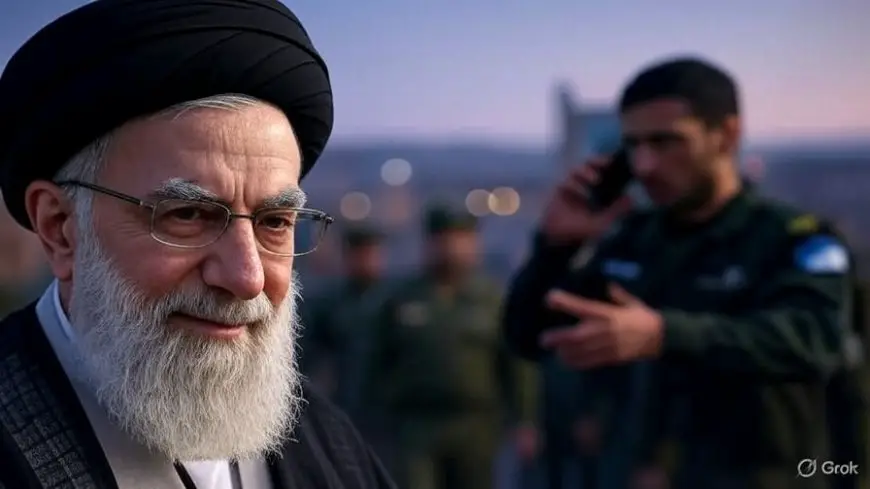“Leave Khamenei or Die”: Israeli Intelligence Warned Iranian Generals 12 Hours Before Covert Strike — Transcription Reveals Tense Call
Israeli intelligence reportedly warned Iranian generals to “Leave Khamenei or die” via a covert phone call before a targeted strike. Read the transcript and analysis.

In an operation that blurs the lines between espionage and psychological warfare, Israeli intelligence reportedly warned Iranian generals by phone just 12 hours before a secretive military strike, telling them to abandon Supreme Leader Ayatollah Ali Khamenei or face lethal consequences.
The striking ultimatum, which sources say was part of a broader precision operation, was accompanied by a direct voice message sent through a scrambled and trace-proof connection, likely routed through compromised communication infrastructure inside Iran.
The Israeli side has not confirmed the message publicly, but excerpts from the alleged transcription of the call have surfaced through regional intelligence intermediaries. The warning underscores an aggressive shift in Israeli counterterrorism operations—where psychological messaging and surgical strikes now go hand in hand.
What Happened: Operation Overview
The event in question occurred hours before a suspected Israeli airstrike destroyed a covert command post believed to be facilitating missile coordination between the Islamic Revolutionary Guard Corps (IRGC) and pro-Iranian militias in Syria and Lebanon.
Shortly before the strike, several high-ranking IRGC officials stationed at the facility received a cryptic phone call—delivered via an encrypted satellite route—that left no room for doubt.
Exclusive: Transcription of the Alleged Phone Call
While the exact voice or origin of the call cannot be independently verified, the following translated transcript is believed to reflect what was said. The original communication was allegedly conducted in Farsi, but intelligence sources released the English rendering to allied governments.
Call Timestamp: 02:43 AM Tehran Time
Duration: 1 minute, 42 seconds
Mode: Encrypted Satellite Relay
Recipients: Senior IRGC Officers near a command outpost in Isfahan
Transcript Begins:
Voice (Unknown Israeli Operative):
“This is not a negotiation. You are being watched.”
Pause
Voice (continued):
“You have twelve hours. Walk away from the Supreme Leader. Abandon your post. Leave Khamenei or die.”
Pause.
Voice:
“We know your position. We know what you planned. You will not leave that building alive if you stay.”
Final words:
“This is your only warning. The countdown has already begun.”
Line disconnects.
Transcript Ends
Targeted Strike Follows Hours Later
Roughly nine hours after the message, surveillance drones tracked unusual vehicle movement from the location. Some IRGC commanders allegedly evacuated the site, while others remained—either disbelieving the warning or under orders to hold position.
At approximately 11:18 AM local time, a precision-guided munition destroyed the building, resulting in multiple fatalities. While Iranian state media labeled it a “technical incident,” satellite imagery and independent verification from private defense firms confirmed blast patterns consistent with an aerial strike.
The Strategy: Targeted Messaging, Maximum Impact
Security experts say the call was never meant to be subtle.
“This wasn’t psychological warfare in the abstract—it was operational theater,” said Meir Javedanfar, a Middle East analyst specializing in Israel-Iran relations. “The goal wasn’t just to eliminate targets but to dismantle morale, challenge loyalty to Khamenei, and show the IRGC that they’re penetrable.”
This aligns with Israel’s doctrine of “mabam”—the campaign between wars—which favors short, deniable, and highly strategic engagements over full-scale confrontations.
Iran’s Response: Denials and Disarray
Despite growing evidence, Tehran continues to deny that the strike took place at all, claiming that the reports are “fabrications” designed to undermine national unity. Behind closed doors, however, sources suggest that counterintelligence investigations have been launched, and several internal communication protocols have been revised in the days following the incident.
Meanwhile, Iran has begun shifting key military figures to more secure, undisclosed locations—a move analysts interpret as proof that the warning hit its mark.
What’s Next?
The confrontation has increased speculation that Israel is preparing a wider campaign of deterrence against Iran’s command hierarchy, especially as nuclear tensions re-emerge in global discussions.
There are also rising concerns that proxy retaliation from Hezbollah or Houthis may soon follow, increasing the risk of a broader regional flashpoint.
As one senior U.S. defense official anonymously stated, “This is no longer a theoretical standoff. It’s active and personal—and messages like this make it undeniable.”
Final Word
The phrase “Leave Khamenei or die” may have sounded like a theatrical threat—but its deadly consequences prove otherwise. With Israel ramping up its intelligence operations and Iran’s high command increasingly on edge, the region could be heading into a new phase of hybrid conflict, where voice messages and airstrikes operate on the same deadly timeline.














